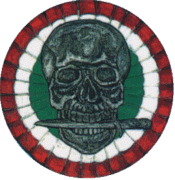Anti-Communist Volunteer Militia
| Anti-Communist Volunteer Militia Milizia Volontaria Anti Comunista (MVAC) | |
|---|---|
 | |
| Active | 1941–1943 |
| Allegiance |
|
The Anti-Communist Volunteer Militia (Italian: Milizia Volontaria Anti Comunista, MVAC) were local armed auxiliary units composed of Chetniks and Slovene anti-Partisans in Italian-occupied parts of Yugoslavia. The same name was contemporaneously used to designate both similar Slovenian auxiliary units whom sided with the Italian authorities in the Italian-annexed part of Slovenia and also some Montenegrin auxiliaries in Montenegro.
History
The Anti Communist Volunteer Militia was formally established by the Italo-Croatian Roatta-Pavelić Official Agreement of the 19 June 1942.[1] On 23 June 1942, assisted by Chetnik leader Ilija Trifunović-Birčanin, the Italians set up the first units of Anti-Communist Volunteer Militia, dedicated to "the annihilation of communism" and under Italian control.[2] In 1942 and 1943, an overwhelming proportion of Chetniks in Italian-occupied parts of the NDH acted as Italian auxiliary forces in the MVAC and were equipped with arms, ammunition and clothing by the Italians.[1] According to General Giacomo Zanussi there were between 19,000 and 20,000 Chetniks in the MVAC which were supplied with 30,000 rifles, 500 machine guns, 100 mortars, 15 pieces of artillery, 250,000 hand grenades, 7 million rounds, and 7,000-8,000 pairs of shoes.[1]
From 1941 local auxiliaries already operated with the Italian forces commands in Montenegro, Bosnia and Herzegovina and Lika from 1942 also in Dalmatia. It was in Dalmatia that those units were initially named for the first time as "Anti Communist Volunteer Bands", a name who - later modified - became of general and official use with the reorganization of June 1942. Chetnik units where legalized by the Italians in the Independent State of Croatia from mid-1942.[3] As early as June 1942, about 4,500 Chetniks served in Montenegro, and on February 28, 1943 about 20,514 Chetniks served in the territory of the Independent State of Croatia.[4]
On 6 August 1942 also the pre-existing - 7,000 men strong - local auxiliary military formations of the Italian administered part of Slovenia - the "Guardia Civica" ("Vaška straža" or Civic (Village) Guard) and the "Legione della Morte" ("Legija Smrti" or "Legion of Death" also known as "Bela garda" or "White Guard"), whose components were enlisted from the members of Slovenian Roman Catholic political parties - were jointly formally renamed by the Italian Supersloda - "Comando Superiore di Slovenia e Dalmazia" as "M.V.A.C." or "Milizia Volontaria Anti Comunista" despite both of them maintained their different and distinctive characteristics - some or also large part of their previous autonomy - and usually their original names in the common use too.
Units
| Unit | Orthodox | Catholics | Muslims | Total | Units | Divisions |
|---|---|---|---|---|---|---|
| Vth Army Corps | 4,313 | 4,313 | 20 | Lombardia 2, Re 18 | ||
| VIth Army Corps | 8,385 | 511 | 780 | 9,676 | 22 | Marche 6, Messina 2, Murge 14 |
| XVIIth Army Corps | 7,816 | 321 | 8,137 | 21 | Sassari 17, Bergamo 4 | |
| Total (occupied zone) | 20,514 | 832 | 780 | 22,126 | ||
| Slovenia (XIth A.C.) | 5,145 | 40 | Isonzo, Cacciatori delle Alpi, Frontier Guards | |||
| Dalmatia (XVIIIth A.C.) | 882 | 13 | ||||
| Kotor (VIth A.C.) | 1,474 | 3 | ||||
| Total (annexed zone) | 7,501 | |||||
| Grand total | 29,627 |
Amongst the irregular Bande who also supported the Italian military commands and civil administration and the regular Bande V.A.C. the more numerous and important was the Orthodox one of Momčilo Đujić, an Orthodox priest and pre-war famous political activist yet known as "Father Fire" for his inflamed sermons. A 780 men-strong battalion of pro-Chetnik Muslims under the leadership of Ismet Popovac, a Muslim physician from Mostar, actively operated with the Italians during 1942 till it was destroyed in action.
See also
Notes
- 1 2 3 4 Tomasevich 2001, pp. 216-217.
- ↑ Rodogno 2006, pp. 307-308.
- ↑ Bosworth 2009, p. 425.
- ↑ Vucinich 1974, p. 274.
References
| Wikimedia Commons has media related to Anti-Communist Volunteer Militia. |
Books
- Bosworth, R. J. B. (2009). The Oxford Handbook of Fascism. Oxford: Oxford University Press. ISBN 0-19-929131-4.
- Rodogno, Davide (2006). Fascism's European Empire: Italian Occupation during the Second World War. Cambridge: Cambridge University Press. ISBN 0-521-84515-7.
- Tomasevich, Jozo (1975). War and Revolution in Yugoslavia, 1941–1945: The Chetniks. Stanford: Stanford University Press. ISBN 978-0-8047-0857-9.
Journal articles
- Vucinich, Wayne S. (September 1974). "Yugoslav Resistance in the Second World War: The Continued Debate". Reviews in European History. 1 (2).